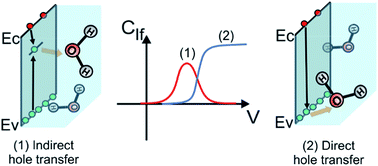Charge transfer processes at the semiconductor/electrolyte interface for solar fuel production: insight from impedance spectroscopy†
Abstract
Knowledge of the nature of charge transfer processes at the semiconductor/electrolyte interface is crucial for the optimization of semiconductors used for solar fuel production. In the literature, there are two types of charge transfer mechanisms: (i) direct hole transfer from the valence band and (ii) indirect hole transfer via surface states. In this paper, we discuss both processes in the steady state regime through full drift-diffusion simulations considering the concomitant influence of the electric field and surface states at the semiconductor/electrolyte interface. We discuss the role of surface states and valence band holes in the photo-anodic current. We subsequently analyze both hole transfer processes in a dynamic regime via the impedance spectroscopy (IS) method. We provide a solid criterion to discriminate both mechanisms and discuss some experimental examples from the literature.

- This article is part of the themed collection: Water splitting and photocatalysis

 Please wait while we load your content...
Please wait while we load your content...